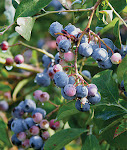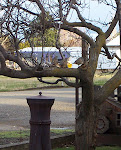Last spring I discovered some turmeric rhizomes (root cuttings), at a local market, and decided to try growing them! I tried a few in water and some in soil, ultimately planting all of them in soil. At first I was very disappointed, thinking that they would never grow. The rhizomes stayed hard and healthy so I just kept watering them and waiting. Be patient! It took a couple of months to get them growing.
Here we are about 9 months later and the beautiful plants are beginning to go dormant. Time to remove them from the pot, separate the rhizomes and start again. Before starting this years crop I need to get some larger/longer containers that will still be narrow enough to fit in the windows.
After looking through all of my garden pictures taken in 2018, there isn't one picture of either the turmeric or the ginger plants!! How did I manage that?
On to the steps for growing Turmeric indoors & outdoors...
> Start them early in the spring, indoors. They take 8 to 12 months to mature to a good size.
> Use a rich, good quality potting mix, that drains well but retains moisture. Be sure your pots have good drainage.
> Plant rhizomes 2" (two inches) deep with one or two buds on each piece. Break up the rhizomes to get more to plant! The larger the pot, the larger the rhizomes, so don't over crowd your pots.
> Stagger your plantings for a continuous supply of rhizomes.
> Keep soil moist but not wet/soggy, needs good drainage. Water every few days to once a week, depending on the temperature of your home, or if outside, the temperature and weather. Water less if it's cold.
> Likes to be warm, so if you plan to set your plants outside in the summer be sure the night time temperature is above 60 degrees F.
> Prefers a sunny location but will tolerate some shade.
> Fertilize with an organic fertilizer twice a month
So, 8-12 months have passed, your turmeric is going dormant. Now what? Time to dig up, or tip the pot out and retrieve those wonderful rhizomes! Select the ones for replanting and begin the repotting.
You have several beautiful rhizomes left to use in cooking, teas, or other uses, and you want to dry them for making into powder. Below is one of the many suggested ways to process to go from fresh to dried.
To process turmeric:
Boil the rhizomes for about 45 minutes.
Let them dry on a drying rack, in a cool, dry place for about one week.
After the rhizomes are completely dry, peel them. You might want to wear gloves, as the dried root will turn your hands orange.
After peeling, grind up the root into a fine powder to use as a spice or as a tea.
For more information on using turmeric, please search the many websites available!


















































